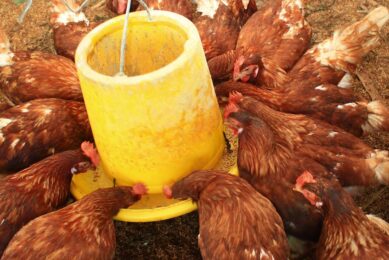“Disease resistance influenced by egg colour”
![Whiter eggs are a clear indication for higher natural antibody levels of the hatched chicks. [Photo: Henk Riswick]](https://www.poultryworld.net/app/uploads/2021/04/001_606_rb-image-2763749-848x565.jpeg)
In his search on the workings of broad-acting, natural antibodies from white laying hens, Ph.D. candidate Tom Berghof came across a surprising genetic link between the mother hen’s eggshell colour and the natural antibody levels of the descendants. His conclusion: eggshell colour indicates how much natural antibodies the chicks will have.
Tom Berghof is a PhD candidate at Adaptation Physiology Group and Animal Breeding at the Genomics Centre at Wageningen University, Department of Animal Sciences. As a PhD candidate, he is a researcher in the project ‘Divergent selection for natural antibodies in poultry’. For the last 10 years, the natural antibodies of chicks that he examines are known only in scientific circles, according to Berghof. “In Canada, over the past few years, the University of Guelph has conducted research on natural antibodies, especially in cattle. The research into poultry has been ongoing since 2004.”
|
The Ph.D. candidate has been participating in this poultry project for about 2 years. The project was set up by Wageningen University in collaboration with Hendrix Genetics/ISA in Boxmeer and the Technology Foundation STW in the Netherlands. Berghof: “A previous project investigated the level of natural antibodies in the purebred laying hen lines of Hendrix Genetics/ISA. It showed that laying hens with more natural antibodies had a higher survival rate during a laying period, suggesting that natural antibodies are involved in general disease resistance.”
Focus on natural antibiodies in hens
According to Berghof, a clear distinction must be made between ‘classical’ specific antibodies, which are antibodies that are made in response to a specific pathogen entering a hen, and the already present natural antibodies. “We focus on this second group of broad-acting antibodies and try, via selective breeding, to increase them in the hen.” Specific antibodies function better against specific pathogens, but they also have a big disadvantage. “Specific antibodies need time to be produced and do their work. In addition, they are specific to only one antigen. The big advantage of natural antibodies is that they address the pathogen directly since they are already (naturally) present, yet with less specificity. They form a ‘non-specific’ barrier that works immediately and wards the pathogen off or delays infection.”
Also interesting: Restoring the hatchability of stored eggs
Poor or prolonged storage of incubating eggs leads to major losses in hatch results. Restoring the hatchability of stored eggs is now possible by the commercial application of heat treatment during egg storage.
Natural antibodies (NAb) may be affected by feeding and microbiota, but how is not yet known. Currently, it is better and more useful to breed a more consistently healthy and robust population of hens that, genetically, have a considerable buffer of NAb, according to Berghof. “So currently we breed for NAb here in Wageningen. A unique project in the world.” When Berghof entered the project, 2 years ago, he started with the base generation of 3,700 white laying hens. Currently he is working with the 5th generation of hens. Each successive generation has more NAb. Berghof: “We select divergently, which means that we breed a line with low NAb levels and a line with high NAb levels. The contrast is needed to show that a population with a higher NAb level experiences lower mortality than a population with a lower NAb level.”
Disease resistance tests
During every generation, at 16 weeks of age, blood samples are taken from the chickens and examined using the ELISA method on the number of NAb that bind to a specific antigen. This examination concerns the antigen Keyhole Limpet Hemocyanin (KLH). Berghof: “This protein comes from the Californian sea slug, but the weird thing is that all birds have a certain number of natural antibodies against this protein. Interestingly, the hens in this research have antibodies against any foreign substance tested so far.” Berghof specifically chose KLH because, in the KLH binding antibodies a very large diversity in NAb levels is found. “And that fits in perfectly with this selection research, because if you want to breed for NAb levels, you need variation. Without variation, you cannot select for the differences.” One more important reason why Berghof chose KLH is that NAb against this antigen were previously shown to have an association with lower mortality among hens.
In addition to the breeding programme, differences in disease resistance are also being tested. The results of these tests will be known by around the summer of 2017. “The first test is completed and looks promising, but we must repeat and verify our results.” Berghof expects that in 2017/2018 field tests with both low and high NAb lines will be done.
Also interesting: Interview: Is robotic egg collection the future?
Chickens lay most of their eggs in their nests, but some end up in the hay. Egg collection is therefore both necessary and time-consuming. In response to this need, Wageningen researchers in the Netherlands have developed an autonomous robot that can move through the poultry house freely.
Relationship between eggshell colour and NAb
During his research, Berghof accidently encountered a different relationship, i.e. between the mother’s eggshell colour and NAb levels in offspring. “This means that the eggshell colour of the mother has a genetic relationship with the general disease resistance of her offspring. At least for the white laying line we used; for other (brown) laying lines, we still have to test this.” ISA measures the eggshell colour of most of their hens and our base population. “One of my supervisors advised me to check the relationship between NAb levels and the production traits of the mother.” Yet Berghof cannot explain the relationship between eggshell colour and natural resistance. In current scientific literature, no work has been done on this relationship, as far as we know.”
The whiter the egg shell the hight the NAb level
In the test, white eggs were compared with one another. The conclusion draw is that, if the mother’s eggs are whiter, the NAb level of the offspring is higher than the NAb levels of offspring originating from mothers with less white eggs. Berghof also found a relationship with the eggshell breaking strength, but this relationship was different. “The relationship eggshell colour/NAb level is stronger than the relationship of eggshell strength/NAb level.” Although the discoveries the PhD candidate has made might be very important, he’s not going to expand on these discoveries too much. “I must continue to focus on the current project. Possibly colleagues from other universities might have interesting thoughts on this.”
Production features important
Although he’s not directly focusing on the relationships he has found, Berghof will continue to track how the production features of the hens change due to further selection. “You might expect that hens with a higher NAb level lay whiter eggs than hens with a lower NAb level. Whether this is the case, we will see. If further research is going to be done on the relationship between eggshell colour and NAb level, it might also be good to check other white laying lines and hens that lay brown eggs.” Perhaps Berghof will expand on this subject in the future.
From the results at the start of 2015, it also emerged that the number of laid eggs per hen hardly corresponded with the levels of natural antibodies. Berghof: “That’s very good news. So when we breed for NAb, this likely does not lead to lower egg production.” Nevertheless, the PhD candidate continues to screen production features such as egg production, growth, eggshell colour, breaking strength and feed conversion, next to feather pecking, within all lines of research. He wants to know for sure that there are no negative relationships concerning the production features, allowing breeding for NAb (and possibly general disease resistance) without negative consequences.
Join 31,000+ subscribers
Subscribe to our newsletter to stay updated about all the need-to-know content in the poultry sector, three times a week. Beheer
Beheer
 Biography
Biography










 WP Admin
WP Admin  Bewerk bericht
Bewerk bericht